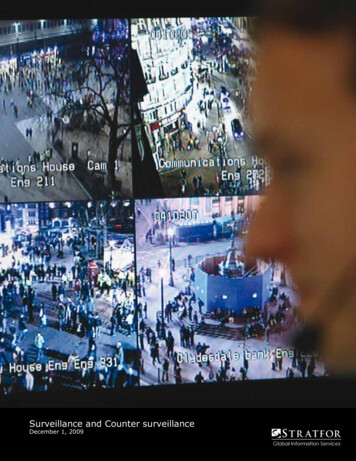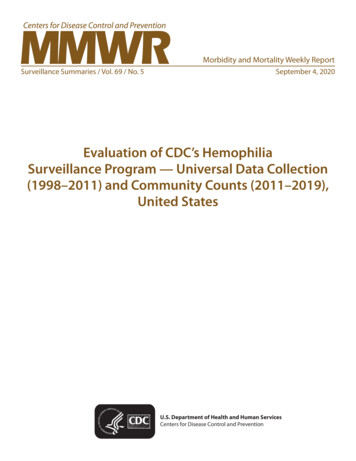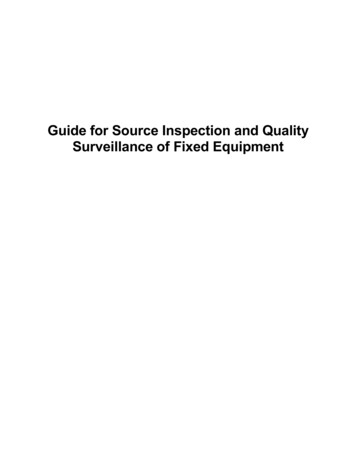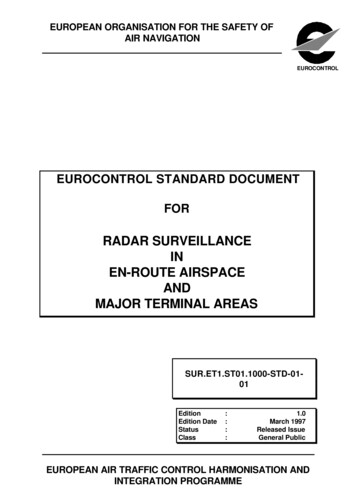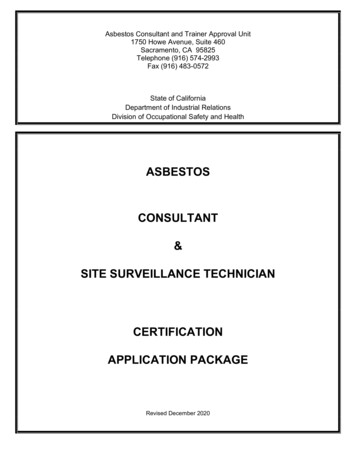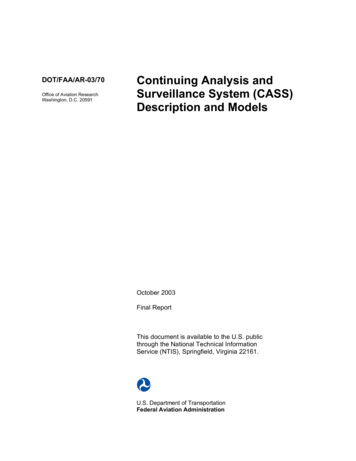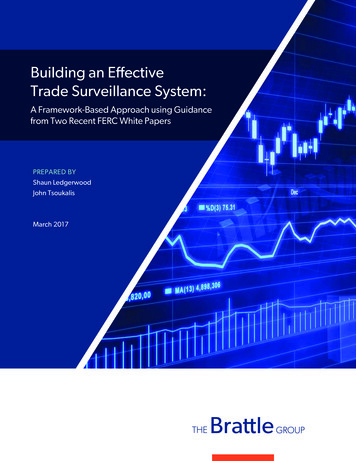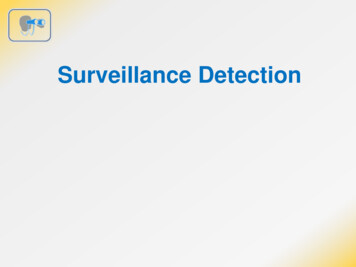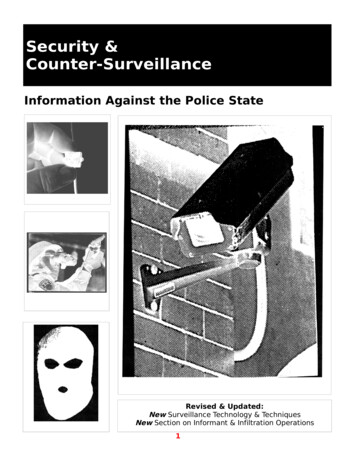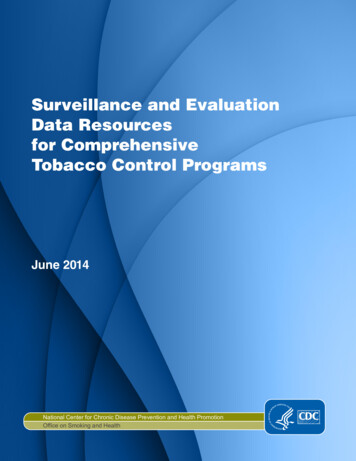
Transcription
Surveillance and EvaluationData Resourcesfor ComprehensiveTobacco Control ProgramsJune 2014National Center for Chronic Disease Prevention and Health PromotionOffice on Smoking and Health
Web site addresses of nonfederal organizations are provided solely as a service to readers. Provision of anaddress does not constitute an endorsement of this organization by CDC or the federal government, andnone should be inferred. CDC is not responsible for the content of other organizations’ Web pages.Suggested citation: Centers for Disease Control and Prevention. Surveillance and Evaluation Data Resourcesfor Comprehensive Tobacco Control Programs. Atlanta, GA: Centers for Disease Control and Prevention,National Center for Chronic Disease Prevention and Health Promotion, Office on Smoking and Health;2014.
Table of ContentsAbout This Book . 1Table 1. National and State Surveys and Tools. 3Adult Tobacco SurveyAlaska Native Adult Tobacco SurveyAmerican Indian Adult Tobacco SurveyBehavioral Risk Factor Surveillance SystemHispanic/Latino Adult Tobacco Survey GuideMonitoring the FutureNational Adult Tobacco SurveyNational Health and Nutrition Examination SurveyNational Health Interview SurveyNational Survey on Drug Use and HealthNational Youth Tobacco SurveyPregnancy Risk Assessment Monitoring SystemSchool Health Policies and Practices StudySchool Health ProfilesSmoking-Attributable Morbidity, Mortality, and Economic CostsState Tobacco Activities Tracking and Evaluation SystemTobacco Use Supplement to the Current Population SurveyYouth Risk Behavior Surveillance SystemYouth Tobacco SurveyTable 2. Registries and Vital Statistics.11National Program of Cancer RegistriesNational Vital Statistics SystemTable 3. Topic-Specific Tools: Health Systems and Clinical Settings.12Healthcare Effectiveness Data and Information SetHospital Discharge DataNational Ambulatory Medical Care SurveyNational Hospital Ambulatory Medical Care SurveyNational Mental Health Services SurveyNational Quitline Data WarehouseNational Survey of Substance Abuse Treatment ServicesTable 4. Topic-Specific Tools: Sales Data.15Food and Drug Administration Compliance ChecksInformation Resources, Inc.Scanner DataSubstance Abuse and Mental Health Services AdministrationTax Revenue Datai
Table 5. Topic-Specific Tools: National, State, and Local Policy Tracking.16ACTIVE Life Tobacco Free Worksite SurveyAmerican College Health Association College Campus Tobacco Cessation and Prevention SurveyAmerican Lung Association’s State Legislated Actions on Tobacco IssuesAmerican Nonsmokers’ Rights Foundation: US Tobacco Control Laws DatabaseCalifornia Student Tobacco SurveyCalifornia Tobacco Use Prevention Education Evaluation: Teacher SurveyCDC School Health ProfilesWorksite and Restaurant Smoking Policy Questionnaires and GuideTable 6. Topic-Specific Tools: Media Tracking.19Adobe SiteCatalystArbitronCisionClicktracks OptimizerDataSiftFacebook InsightsGnipGoogle AnalyticsHootSuiteLegacy Media Tracking Survey and Legacy Media Tracking yWebalyzerYouTube AnalyticsTable 7. Topic-Specific Tools: Tobacco Industry Monitoring.24Network of the National Cancer InstituteNew Product Watch, funded by Tobacco Surveillance, Epidemiology, and EvaluationProject SMART Money of California State Department of Public HealthRetail Advertising Tobacco SurveyUniversity of California at San Francisco Tobacco Control ArchivesTable 8. Global Surveys and Tools.25Global Adult Tobacco SurveyGlobal Health Professions Student SurveyGlobal School Personnel SurveyGlobal School-Based Student Health SurveyGlobal Youth Tobacco SurveyAbbreviations.27ii
About This BookSurveillance and Evaluation Data Resources is an at-a-glance compilation of surveillance and evaluationresources for comprehensive tobacco control programs. This booklet is meant to be used by programmanagers and evaluators in planning and evaluating tobacco control programs. Its primary objective is toprovide basic information on each data source to assist state tobacco control programs to identify sourcesthat can help with planning, monitoring, and evaluation. A discussion of when and how to use theseresources is addressed in other evaluation workbooks and manuals such as Key Outcome Indicators forEvaluating Comprehensive Tobacco Control Programs and Introduction to Process Evaluation in Tobacco UsePrevention and Control, and during technical assistance events. These and other resources are available athttp://www.cdc.gov/tobacco/tobacco control programs/surveillance evaluation/index.htm.Users of this booklet are encouraged to review and assess the appropriateness of these resources in meetingtheir program’s needs. The data sources listed here provide a wide variety of tobacco-related information. Forexample, restaurant and worksite surveys address environmental policies and indicators; the Youth TobaccoSurvey, Adult Tobacco Survey, and media evaluation surveys address individual knowledge, attitudes, andbehaviors; and the cancer registries and hospital discharge records address health outcomes. Given that thefield of tobacco control continues to evolve over time, it is not possible to provide an exhaustive summary ofcurrently available data sources. Therefore, this booklet outlines only the most relevant and comprehensiveresources available for achieving state tobacco control program objectives.Sources that are used frequently and are compatible across states are often employed to help states developtobacco program objectives. Data from these sources can be used to compare program impact andoutcomes with those of other states and the nation as a whole. Data from some of the listed resources arerestricted and require purchase.The data sources are organized by major categories: National and state surveys and tools, registries andvital statistics, topic-specific tools, and global surveys and tools. The columns in each table provide thefollowing information:Column 1: Purpose§ Purpose(s) of the data source or tool.Column 2: Topics Addressed§ Topics on which information is collected or available for the data source or tool, such as secondhandsmoke, tobacco use, knowledge and attitudes, tobacco-related policies, or quit attempts.Column 3: Sampling Frame and Data Collection§ Population from which the sample is taken, such as high schools, all visitors to a Web site, or US adults.§ Lead organization or agency for collecting and disseminating the data.Column 4: Methodology§ Subject selection: How the sample population was selected (for example, random sampling or census)and the unit of analysis (for example, household, individual, or school).§ Survey delivery: How the survey or tool was administered (for example, self-administered survey or inperson interview).§ Number of core questions.Column 5: Timing and Frequency§ Year the survey or data source was first used.§ How often the data source was used for data collection (for example, annually or periodically).§ Notes on population characteristics, optional questions, and specifics of methods used.1
Not all of the data sources or tools are available in every state. Consequently, some states may want toconsider investing funds to develop systems to address gaps in data. CDC guidelines stateAll federally funded tobacco prevention and con trol programs are expected to engage in strategicsurveillance and program evaluation activities. To accomplish this, best practices dictate that 10% oftotal annual tobacco control program funds be allocated for surveillance and evaluation.It is important that tobacco control programs develop and maintain the appropriate infrastructure toenhance their surveillance and evaluation resources as needed. For example, conducting a detailedevaluation of a specific intervention, such as a cohort study to assess the effectiveness of a mediacampaign, can be resource intensive. Similarly, additional resources beyond the standard 10% oftobacco control program funds may also be required for developing increased technical capacity oflocal programs to perform process and outcome evaluation.”1New data-collection systems should be relevant to specific state programmatic goals, objectives, andactivities. However, prior to choosing data sources or investing program resources to develop newdata systems, programs should consider some of the following issues: feasibility, timeliness, frequency,comparability, credibility, and available resources.For more information on these considerations, states are encouraged to contact their Office on Smokingand Health (OSH) Project Officer or access OSH’s surveillance and evaluation resources on the Centersfor Disease Control and Prevention’s Web site at http://www.cdc.gov/tobacco/tobacco control programs/surveillance evaluation/index.htm.1Best Practices for Comprehensive Tobacco Control Programs—2014. Atlanta, GA: US Department of Health and Human Services;2014: 61. Available at: http://www.cdc.gov/tobacco/stateandcommunity/best practices/index.htm.2
Table 1. National and State Surveys and ToolsPurposeTopics AddressedSampling Frame andData CollectionMethodologyTiming andFrequencyAdult Tobacco Survey (ATS)http://www.cdc.gov/mmwr/PDF/ss/ss5903.pdf Cigarette, cigar, pipe, kretek, To provide state-leveland smokeless tobacco use,data on adult tobaccosecondhand smoke exposure,use, knowledge,and policies.attitudes, and on tobaccouse prevention and Cessation behaviors/quitcontrol policies.attempts. To provide state-level Health care advice.data on long-term, Parental involvement.intermediate, andshort-term indicators Media exposure.key to the design, Risk perception and socialimplementation,influences.and evaluation ofcomprehensive tobacco Emerging product use.control programs. State level. Adults aged 18 years orolder. Data collection: States,territories, districts. Random-digit-dialedlandline and cellulartelephone survey. Questionnairetemplate has 49questions for currentsmokers, 38 forformer smokers, and34 for never smokers. Initiated in 1986. Frequency:Annually,dependent onfunding. State-addedquestions optional.Alaska Native Adult Tobacco Survey (AN ATS)http://www.cdc.gov/tobacco/data statistics/surveys/alaska native/index.htm To enable villages,communities, and otherorganizations to assessthe knowledge, beliefs,and attitudes of tribalmembers about the useof commercial tobacco. Cigarette use and cessation. Use of other tobacco products(i.e., iqmik, chewing [spit], orsnuff [dip] tobacco). Secondhand smoke exposure. Methods used in quit efforts. Village and communitylevel. Alaska Native adultsaged 18 years or older. Data collection: Villagesor communities. Census type,area-based sampleor representative,random, populationbased sample,depending on villageor community size. Initiated in 2007. Frequency:Dependent onAlaska Nativecommunityinterest. Culturally sensitiveface-to-faceinterviewing. Workplace smoke-free policies. Knowledge and risk perceptionsof tobacco use. 143 core questions. Village orcommunitysupplementalquestions optional.American Indian Adult Tobacco Survey (AI ATS)http://www.cdc.gov/tobacco/data statistics/surveys/american indian/index.htm To enable tribes, tribalorganizations, and otherorganizations to assessthe knowledge, beliefs,and attitudes of tribalmembers about the useof commercial tobacco. Commercial cigarette use. Tribal level. Use of other tobacco products(i.e., pipe, chewing [spit], orsnuff [dip] tobacco). American Indian adultsaged 18 years or older. Quit efforts. Data collection: Tribes. Methods used in quit efforts. Census type, areabased sample orrepresentative,random, populationbased sample,depending on tribesize. Secondhand smoke exposure. Culturally sensitiveface-to-faceinterviewing. Knowledge and risk perceptionsof commercial tobacco use. Tribal supplementalquestions optional. Workplace policies on smoking. 160 core questions.3 Initiated in 2005. Frequency:Dependent ontribal interest.
Table 1. National and State Surveys and ToolsPurposeTopics AddressedSampling Frame andData CollectionMethodologyTiming andFrequencyBehavioral Risk Factor Surveillance System (BRFSS)http://www.cdc.gov/brfss The tobacco topics may vary by To provide descriptiveyear and can includedata about health-relatedrisk behaviors and» Cigarette and smokelessevents, chronic healthtobacco use.conditions, and use of»Age of initiation.preventive services.» Cessation behaviors. State level. Adults aged 18 years orolder. Data collection: CDC. Random-digit-dialedlandline and cellulartelephone survey. Core survey has fivequestions related totobacco use. Initiated in 1984. Frequency:Annually. Optional modules forsmoking cessationand secondhandsmoke.» Secondhand smoke policiesand rules.Hispanic/Latino Adult Tobacco Survey Guide (H/L ATS)http://www.cdc.gov/tobacco/data statistics/surveys/hispanic latino ats guide/index.htm To measure the tobaccorelated behaviors,knowledge, attitudes,and opinions of Hispanicand Latino persons. General health. Tobacco use. Cessation. Secondhand smoke exposure. Risk perceptions, socialinfluences, and demographicsamong Hispanic and Latinoadults. Standard list-assisted, Initiated in 2002.random-digit-dial Frequency: Hispanic/Latino adultsor area sampling,Dependent onaged 18 years or older.depending oninterest. Data collection: Institutecommunity size.that commissions the Telephone interviewsurvey.or in-personinterview in Englishor Spanish. All levels. 56 core questions. Questions reflectexperience andlanguage ofHispanic/Latinopersons. Spanish translationwas carefullydeveloped to beunderstood bySpanish-speakersfrom variouscountries of origin. Cognitively testedin Chicago, IL; LosAngeles, CA; Miami,FL; New York, NY;San Antonio, TX;El Paso, TX; andWashington, DCduring 2004–2005.4
Table 1. National and State Surveys and ToolsPurposeTopics AddressedSampling Frame andData CollectionMethodologyTiming andFrequencyMonitoring the Future (MTF)http://monitoringthefuture.org To provide annualdata on behaviors,knowledge, attitudes,and values related tothe use of an array ofpsychoactive substances,both illicit and licit,among Americansecondary schoolstudents, collegestudents, and youngadults. Cigarette use. National level. Age of initiation. Students in grades 8,10, and 12, and youngadults. Cessation behavior. Brand preference. Youth access. Enforcement. Data collection:National Institute onDrug Abuse. Random design,self-administered,school-based surveywith follow-upsurvey mailed tocohort population. Initiated in 1975. Frequency:Annually. Number of questions:3 to 64. Media awareness.National Adult Tobacco Survey (NATS)http://www.cdc.gov/tobacco/data statistics/surveys/nats To provide data on adulttobacco use, knowledge,attitudes, purchasingbehaviors, and ontobacco use preventionand control policies. Cigarette, cigar, pipe, hookah,kretek, e-cigarette, chewingtobacco, and smokeless tobaccouse. National level. Data collection: CDC. To provide nationaldata on long-term,intermediate, andshort-term indicatorskey to the design,implementation,and evaluation ofcomprehensive tobaccoprevention and controlprograms. Susceptibility to cigarettesmoking initiation. Secondhand smoke exposureand smoke-free policies. Noninstitutionalizedadults aged 18 years orolder. Stratified, randomdigit-dialed landlineand cellulartelephone survey ofadults. Interviews conductedin English andSpanish. 130–150 maximumpath core questions. Cessation behaviors/quitattempts. Health care advice. Parental involvement. Media exposure. Risk perception and socialinfluences. New products used. Knowledge, attitudes, andperceptions.5 Initiated in 2009. Frequency:2009–2010, 2012–2013, 2013–2014.
Table 1. National and State Surveys and ToolsPurposeTopics AddressedSampling Frame andData CollectionMethodologyTiming andFrequencyNational Health and Nutrition Examination Survey (NHANES)http://www.cdc.gov/nchs/nhanes/about nhanes.htm To estimate theproportion of persons inthe US population andin designated subgroupswith selected conditions,diseases, and risk factors. To monitor trends in theprevalence, treatment,and control of selecteddiseases. To explore relationshipsbetween diet, nutrition,and health. Cigarette use (current andformer). Age of initiation. Brand preference. Current smokeless tobacco ande-cigarettes use. Secondhand smoke exposureshown by serum cotinine andurinary NNAL biomarkers, andby self-report. National level. Noninstitutionalizedcivilian US population;individuals, all ages. Data collection:National Center forHealth Statistics(NCHS). Complex, multistagecluster probabilitysample. Annual samplesare nationallyrepresentative. Initiated in early1960s. Frequency:Continuous since1999. Because of disclosureconcerns and limitedsample sizes, dataare released in 2-yearcycles. For small populationgroups and for lesscommon diseases,conditions, andrisk factors, severalyears of data may beneeded to produceadequate estimates. To explore emergingpublic health issues. To provide baselinehealth characteristics tolink with mortality datafrom the National DeathIndex (http://www.cdc.gov/nchs/ndi.htm) andother administrativerecords. Household interviewand physicalmeasurements inmobile examinationcenter.National Health Interview Survey (NHIS)http://www.cdc.gov/nchs/nhis.htmNHIS Adult Tobacco Use: http://www.cdc.gov/nchs/nhis/tobacco.htm To monitor the healthof the US civilian,noninstitutionalizedpopulation includingFor all ages:» Health status.» Activity limitations.» Injuries.» Health insurancecoverage.» Access and use ofhealth care.For adults (18 ),additional informationon: Tobacco topics covered annually: National level.» Cigarette smoking status.» Number of cigarettes smokedper day.» Age of initiation.» Time since quit.» Quit attempt in past year. Multistage clustersample design with Full NHIS: All ages.oversampling of Tobacco questions: Agesblack, Hispanic, and18 .Asian populations. Data collection: NCHS. In-person householdinterview withtelephone follow-up. Annual core andperiodic supplement(special topic)questionnaires. Tobacco topics covered insupplements (selected years):» Non-cigarette smoked tobacco(i.e., cigars, pipes, etc.). Number of corequestions: 8.» Smokeless tobacco use.» Cessation methods.» Secondhand smoke policies.» Health conditions.» Secondhand smoke exposure.» Activity limitations.» Medical advice to quit.» Health behaviors.» Pregnancy and smoking.» Access to and use ofhealth care services.6 Initiated in 1957. Frequency:Continuous(annual datarelease). Cigarette smokingin selected years1964–1965(supplements)and annually since1997. Non-cigarettetobacco productsin selectedyears since 1965(supplements).
Table 1. National and State Surveys and ToolsPurpo
Pinterest Radian6 Sysomos Topsy . YouTube Analytics Table 7. Topic-Specific Tools: Tobacco Industry Monitoring.24 Network of the National Cancer Institute New Product Watch, funded by Tobacco Surveillance, Epidemiology, and Evaluation . Workplace smoke-free policies. Knowled
